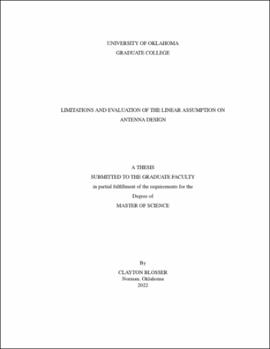| dc.contributor.advisor | Ruyle, Jessica | |
| dc.contributor.author | Blosser, Clayton | |
| dc.date.accessioned | 2022-05-10T21:15:04Z | |
| dc.date.available | 2022-05-10T21:15:04Z | |
| dc.date.issued | 2022-05-13 | |
| dc.identifier.uri | https://hdl.handle.net/11244/335680 | |
| dc.description.abstract | A common assumption made by antenna engineers is to consider a system to be linear and time-invariant (LTI). This assumption is incredibly powerful and has enabled a century of advancements, but consequently has perhaps made electrical engineering too reliant upon it. There are multiple cases of fundamental limits being circumvented by including non-LTI devices and analysis. Additionally, there are limitations of some systems that are not well understood or avoided as a subject due to their non-LTI nature. Exotic antennas are attractive to complex, modern communication systems, but they are effectively useless if they cannot be deployed in practical settings after design sequences - as is sometimes the case in the presence of potentially nonlinear devices. Therefore, this work provides insight into the limitations of non-LTI analysis for antenna engineering and the trade-offs of some antennas that are erroneously capable of nonlinear behavior. Doing so will help shed light on the ramifications of casually making the LTI assumption and methods to better understand such antennas. | en_US |
| dc.language | en_US | en_US |
| dc.subject | Antennas | en_US |
| dc.subject | Nonlinear | en_US |
| dc.subject | Limitations | en_US |
| dc.subject | Reconfigurable | en_US |
| dc.title | Limitations and evaluation of the linear assumption on antenna design | en_US |
| dc.contributor.committeeMember | Kerby-Patel, K.C. | |
| dc.contributor.committeeMember | Sigmarsson, Hjalti | |
| dc.date.manuscript | 2022-05-06 | |
| dc.thesis.degree | Master of Science | en_US |
| ou.group | Gallogly College of Engineering::School of Electrical and Computer Engineering | en_US |
| shareok.orcid | 0000-0002-3568-4241 | en_US |
